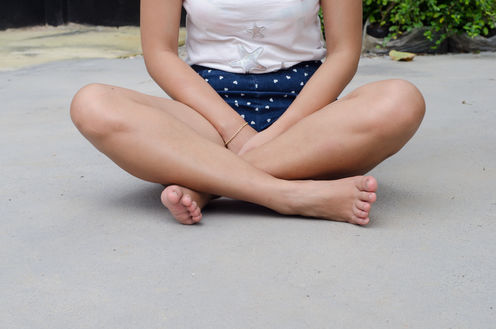
If you have pain in your vulva, you’re not alone. Around 16% of women will have vulvar pain lasting longer than three months. They aren’t neurotic or promiscuous. It’s likely they are suffering from a condition called vulvodynia.
Only people with a vulva can develop vulvodynia, but that’s where the discrimination stops. The condition occurs in women of all ages and ethnicities, regardless of education, skin type, sexual preference or relationship status.
The pain can be brutal and is commonly described as stabbing, burning or knife-like. It might happen only when the vulva is provoked, as when it’s touched by clothing or attempted penetration, or it can be constant. Not surprisingly, vulvodynia can severely impact a woman’s quality of life.
Vulvodynia and its costs
About half of our species has a vulva, yet surprisingly few know what, or where, it is. The vulva refers to the external genitalia of females: the clitoris, labia, vaginal opening and Bartholin’s glands, which provide the natural lubricant for the vagina. It has a rich supply of specialised nerves and gives pleasure when properly stimulated.
The vulva doesn’t extend to the vagina itself, which, contrary to common parlance and high-profile art exhibitions, is on the inside, not the outside.

Putting “-dynia” on the end of a word refers to pain. Vulva means, well, vulva. So vulvodynia literally means “painful vulva”. If you have pain in your vulva anywhere from your clitoris to your anus and labia to very inner thigh, and there is no clear injury or ongoing infection, then you have vulvodynia.
Three out of every 20 women will develop vulvodynia at some point and the cost can be profound. Sufferers often struggle to wear underwear, sit down or use tampons.
Women with vulvodynia often suffer through sex. Some find ways to end their relationships when the pain becomes too unbearable. They can be so embarrassed about their condition they don’t mention it to their partner or tell them it’s the reason they want to separate.
And when it comes to economic costs, extrapolating from a United States study, vulvodynia costs Australia more than A$2 billion per year.
Unfortunately, we don’t know what causes vulvodynia, although we do know a few things that don’t. It used to be considered a result of a woman having too many sexual partners, for instance, but we now know there is no relationship between the two.
Suspected causes
Women with vulvodynia are sensitive in all parts of their body, not just the vulva. They commonly have other painful conditions such as irritable bowel syndrome. This implies changes in the brain information-processing centres that produce pain in these women.
Women with vulvodynia also have higher levels of inflammatory markers in their blood – part of an immune response – than those without. They are more likely to report repeated thrush infections and having had a sexually transmitted disease. This makes some researchers think a possible association exists between the prior infections and inflammation.

Inflammation can induce nerve growth in the vulva region – which might also explain why the vulva becomes hypersensitive in vulvodynia. But girls can have vulvodynia before they report thrush, so it is not as simple as that.
Psychological factors play a part, as they do in any pain state. But it’s difficult to know whether these issues came before or after the pain. The sexual dysfunction associated with vulvodynia may increase depression, which may lead to further sexual dysfunction, for instance. However, some women report symptoms of vulvodynia for the first time following a psychological trauma, such as the death of a parent, partner or friend.
Many women develop vulvodynia during menopause, which indicates hormones may play a role. There may also be a genetic component as women are more likely to develop the condition if someone in their family has, or has had, it.
What should you do if you have vulvar pain?
If you suspect you have vulvodynia, your first step should be to see your GP and ask for a referral to a gynaecologist or vulvar specialist with an interest in treating painful conditions.

Research into understanding vulvodynia is way behind other chronic pain conditions such as back pain, meaning fewer treatment options are available. But your specialist will help you decide on some treatments that are right for you.
A treatment plan will often include medications, advice on management strategies and referral to other health professionals such as physiotherapists or psychologists. Treatments such as massage of the pelvic floor muscles and training to help reduce the tightness in the area could also help.
Anecdotally, we know things you can do at home to reduce the pain. Many women find relief using cool packs or a fan directed towards their vulva. You can avoid using soaps or body washes to clean your vulva; instead, use something like Dermeze soap-free wash or just water.
Ensure you are well lubricated during sex, but some commercial lubricants could aggravate symptoms. Natural alternatives are almond oil and coconut oil.
No woman should suffer in silence or shame because of her symptoms. The Pelvic Pain Foundation of Australia is a great place to find more information on vulvodynia and other pelvic pain conditions.
Jane Chalmers receives funding from The Pelvic Pain Foundation of Australia.
Lorimer Moseley consults to Pfizer Australia, Kaiser Permanente and Providence Healthcare. He receives author royalties for Explain Pain, Explain Pain Handbook: Protectometer, Painful Yarns: Metaphors and stories to help understand the biology of pain, and The Graded Motor Imagery Handbook. He receives speaker fees. Details available on request. He is supported by a Principal Research Fellowship from the National Health & Medical Research Council of Australia and his research is supported by project grants from the National Health & Medical Research Council of Australia.
